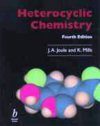![Heterocyclic Chemistry Heterocyclic Chemistry]()
Click to have a closer look
About this book
Contents
Related titles
About this book
Heterocyclic Chemistry has so closely matched the requirements of its readership over the years that it has become the first choice for chemists all over the world. Heterocyclic chemistry comprises at least half of all organic chemistry research worldwide. In particular, the vast majority of organic work done in the pharmaceutical and agrochemical industries is heterocyclic chemistry. The fourth edition of Heterocyclic Chemistry retains its original aims and flavour, thus maintaining the principal objective of earlier editions – to teach the fundamentals of heterocyclic reactivity and synthesis in a way that is understandable to second- and third-year undergraduate chemistry students.
In recognition of the level at which much heterocyclic chemistry is now normally taught, the authors have included more advanced material, making Heterocyclic Chemistry appropriate both for postgraduate taught courses and to postgraduate students. It is important to emphasize that the more advanced sections of Heterocyclic Chemistry make it an important reference work for chemists at all levels who are working with heterocyclic compounds in industry. The preparation of the fourth edition has allowed the authors to review thoroughly the material included in earlier editions, to amend it in the light of new knowledge, and to include much recent work. For example, new sections deal with heterocyclic aspects of combinatorial chemistry, bioprocessing, and conducting polymers.
In its more advanced sections, Heterocyclic Chemistry emphasizes modern methods for the synthesis and chemical manipulation of heterocyclic compounds. Essential teaching material in the early chapters aims to capture the essence of heterocyclic reactivity in concise resumes suitable either as introductions, or as revisions/summaries for examination preparation. These early chapters are followed by detailed, systematic discussions of the chemical reactivity of particular heterocyclic systems. Original references and references to reviews are given throughout the text. These are essential for postgraduate teaching and to research workers, but do not interfere with the readability of the text for undergraduate students. Problems, divided into straightforward revision exercises, and more challenging questions (with solutions as an Appendix), help the reader to understand and apply the principles of heterocyclic reactivity and synthesis.
Contents
Preface. Introduction to the fourth edition. Definitions and abbreviations. 1. Structures and spectroscopic properties of aromatic heterocycles, 2. Reactivity of aromatic heterocycles. 3. Synthesis of aromatic heterocycles. 4. Typical reactivity of pyridines, quinolines and isoquinolines. 5. Pyridines: reactions and synthesis. 6. Quinolines and isoquinolines: reactions and synthesis. 7. Typical reactivity of pyrylium and benzopyrylium ions, pyrones and benzopyrones. 8. Pyryliums, 2- and 4-pyrones: reactions and synthesis. 9. Benzopyryliums, benzopyrones: reactions and synthesis. 10. Typical reactivity of the diazines: pyridazine, pyrimidine and pyrazine. 11. The diazines: pyridazine, pyrimidine, and pyrazine: reactions and synthesis. 12. Typical reactivity of pyrroles, thiophenes, and furans. 13. Pyrroles: reactions and synthesis. 14. Thiophenes: reactions and synthesis. 15. Furans: reactions and synthesis. 16. Typical reactivity of indoles, benzo[b]thiophenes, benzo[b]furans, isoindoles, benzo[c]thiophenes and isobenzofurans. 17. Indoles: reactionsand synthesis. 18. Benzo[b]thiophenes and benzo[b]furans: reactions and synthesis. 19. Isoindoles, benzo[c]thiophenes and isobenzofurans: reactions and synthesis. 21. 1,3-Azoles:imidazoles, thiazoles, and oxazoles: reactions and synthesis. 22. 1,2Azoles: pyrazoles, isothiazoles, isoxazoles: reactions and synthesis. 23. Benzanellated azoles: reactions and synthesis. 24. Purines: reactions and synthesis. 25. Heterocycles containing a ring-junction nitrogen. 26. Heterocycles containing more than two hetero atoms. 27. Saturated and partially unsaturated heterocyclic compounds: 28. Heterocycles at work. Appendix: answers to exercises. Index.
Customer Reviews



































